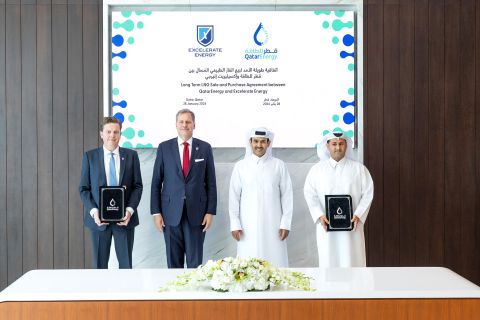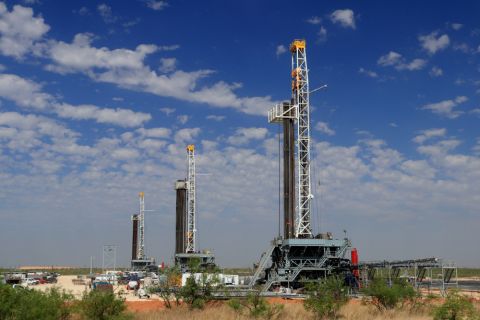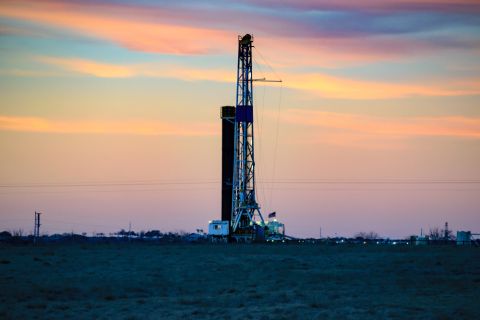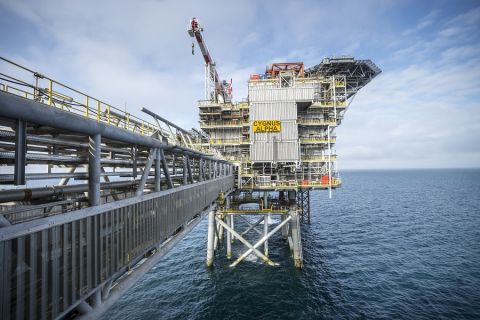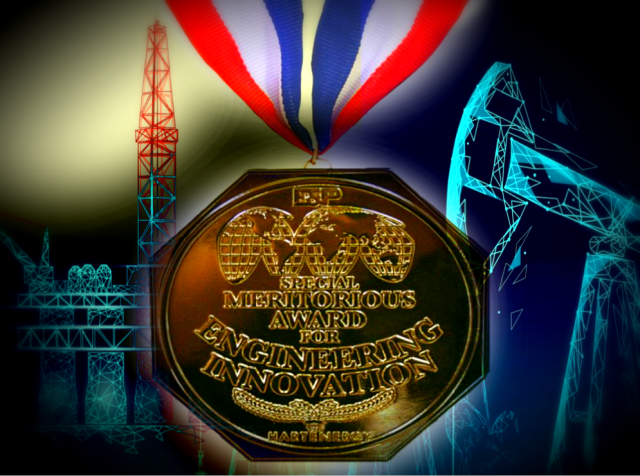
(Source: Hart Energy; Shutterstock.com)
[Editor's note: A version of this story appears in the September 2020 edition of E&P Plus. Subscribe to the magazine here.]
The E&P Plus editors and staff proudly present the winners of the 2020 Special Meritorious Awards for Engineering Innovation (MEAs), which recognize service and operating companies for excellence and achievement in every segment of the upstream petroleum industry. The pages that follow highlight 25 winners picked by an independent team of judges.
The winning technologies represent a broad range of disciplines and address several challenges that pose roadblocks to efficient operations. Winners of each category are products that provided monumental changes in their sectors and represented techniques and technologies that are most likely to improve artificial lift, drill bits, drilling fluids/stimulation, drilling systems, exploration/geoscience, formation evaluation, HSE, hydraulic fracturing/pressure pumping, intelligent systems and components, IOR/EOR/remediation, marine construction and decommissioning, nonfracturing completions, subsea systems and water management.
This year some of the brightest minds in the industry from service and operating companies entered exceptionally innovative products and technologies that have now been measured against the world’s best to be distinguished as the most groundbreaking in concept, design and application.
The awards program recognizes new products and technologies designed by companies and people who understand the need for newer, better and constantly changing technological innovation to appease the energy-hungry world.
The panel of judges comprised experts in business, engineering and the sciences representing operating and consulting companies worldwide. Each judge was assigned a category that best utilized his or her area of expertise. Judges whose companies have a business interest were excluded from participation.
E&P Plus would like to thank these distinguished judges for their efforts in selecting the winners in this year’s competition.
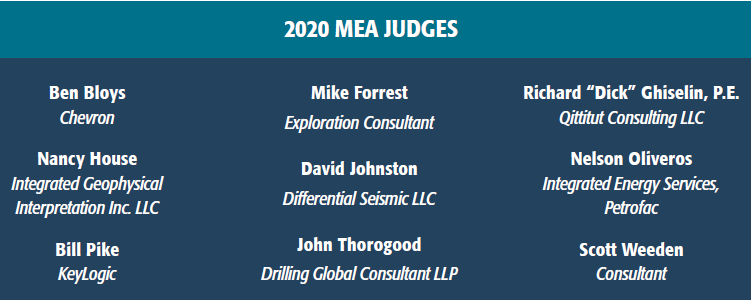
An entry form for the 2021 MEAs competition is available at HartEnergy.com/mea. The deadline for entries is Jan. 31, 2021.
ARTIFICIAL LIFT WINNER
SCHLUMBERGER
REDA CONTINUUM EXTENDED-LIFE ESP PUMP
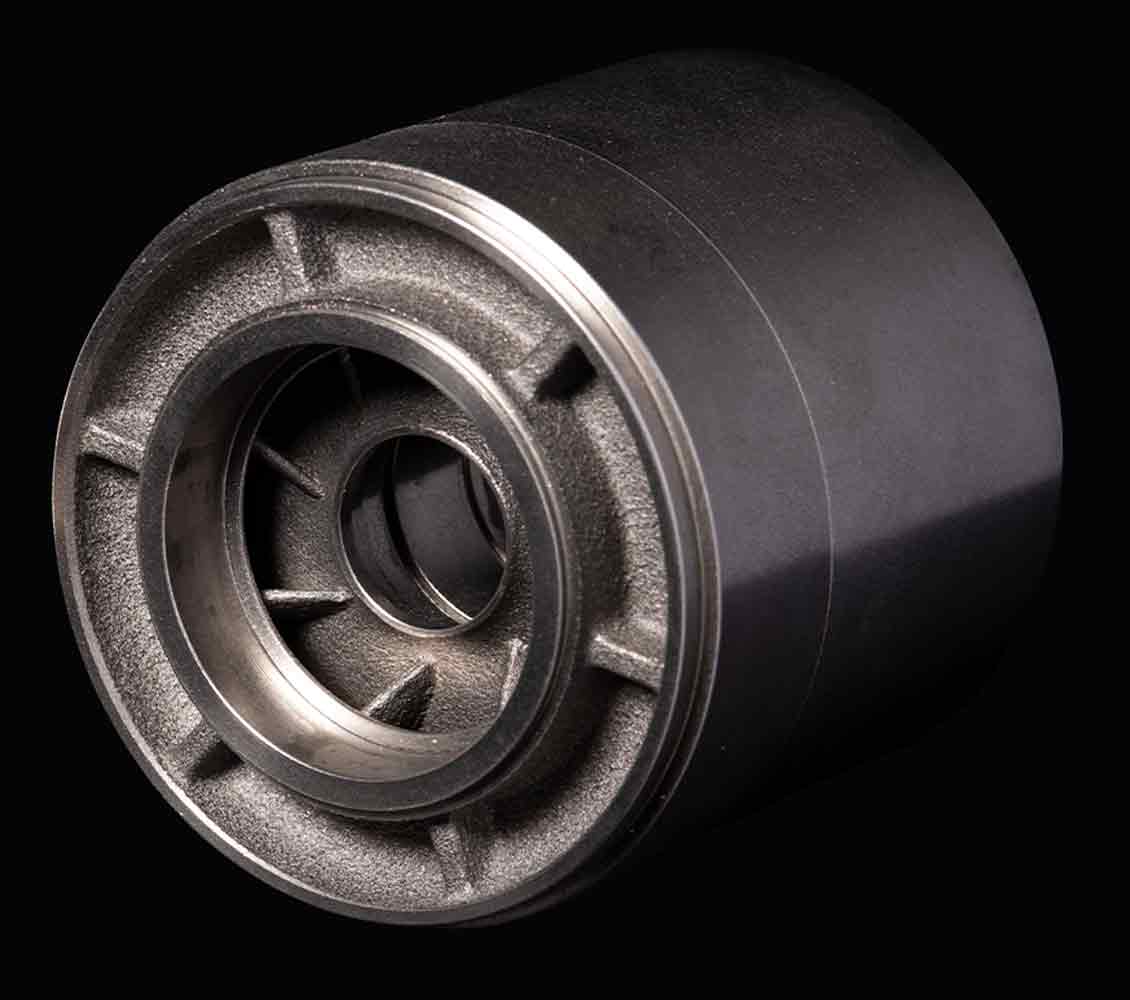
Challenging flow characteristics such as steep flow declines and solids and gas production often exceed the capabilities of conventional electric submersible pumps (ESPs), leading to failures, lost production and reduced runlife. The REDA Continuum extended-life ESP delivers a step change in lift, efficiency, lifetime and power consumption in unconventional and conventional wells with low and slug flow, solids production, frequent stops and starts, and production uncertainty. The result is a significant increase in operators’ ability to produce more oil for longer. The latest Continuum pumps feature an enlarged balance chamber, optimized balance holes and rugged washer designs to limit upthrust and downthrust wear when production exceeds or drops below expectations. Designed for 5½-inch or larger casing sizes, the pumps can handle 200 bbl/d to 7,000 bbl/d, enabling faster drawdown and greater IP compared with the natural flow.
DRILL BITS WINNER
SAUDI ARAMCO
ULTRASTRONG CATALYST-FREE PDC
Polycrystalline diamond compact (PDC) drill bits are essential drilling tools for oil exploration and drilling. Drilling in hard, highly abrasive and interbedded formations is a difficult challenge for today’s PDC bits. Current PDC cutter technology does not provide sufficient wear, impact resistance or thermal stability to achieve the final goal of a single run to drill the entire interval. The weakness in the current technology is due to the use of unavoidable cobalt catalysts needed to bind the diamond grains that compose the PDC cutting structure.
Saudi Aramco’s ultrastrong and catalyst-free PDC material has been successfully synthesized for the first time, setting a new world record as the hardest diamond material to date, according to the company. Its wear resistance is 300% higher than that of the best diamond materials used in the industry. The thermal stability and oxidation resistance of the PDC cutter also broke the industry records by an increase of about 600 C.
In a case study, catalyst-free PDC with ultrahigh wear resistance was successfully synthesized under an extremely high pressure of 16 GPa and ultrahigh temperature of 2,300 C for the first time. The wear resistance, hardness and thermal stability were symmetrically evaluated. The results showed that the new material possesses an exceptionally high wear resistance of more than 300% higher than that of the best commercial PDC materials used in the industry. The material also broke all the diamond indenters during the hardness testing, indicating the world’s hardest material to date.

DRILL BITS WINNER
SMITH BITS, A SCHLUMBERGER COMPANY
AEGIS ARMOR CLADDING
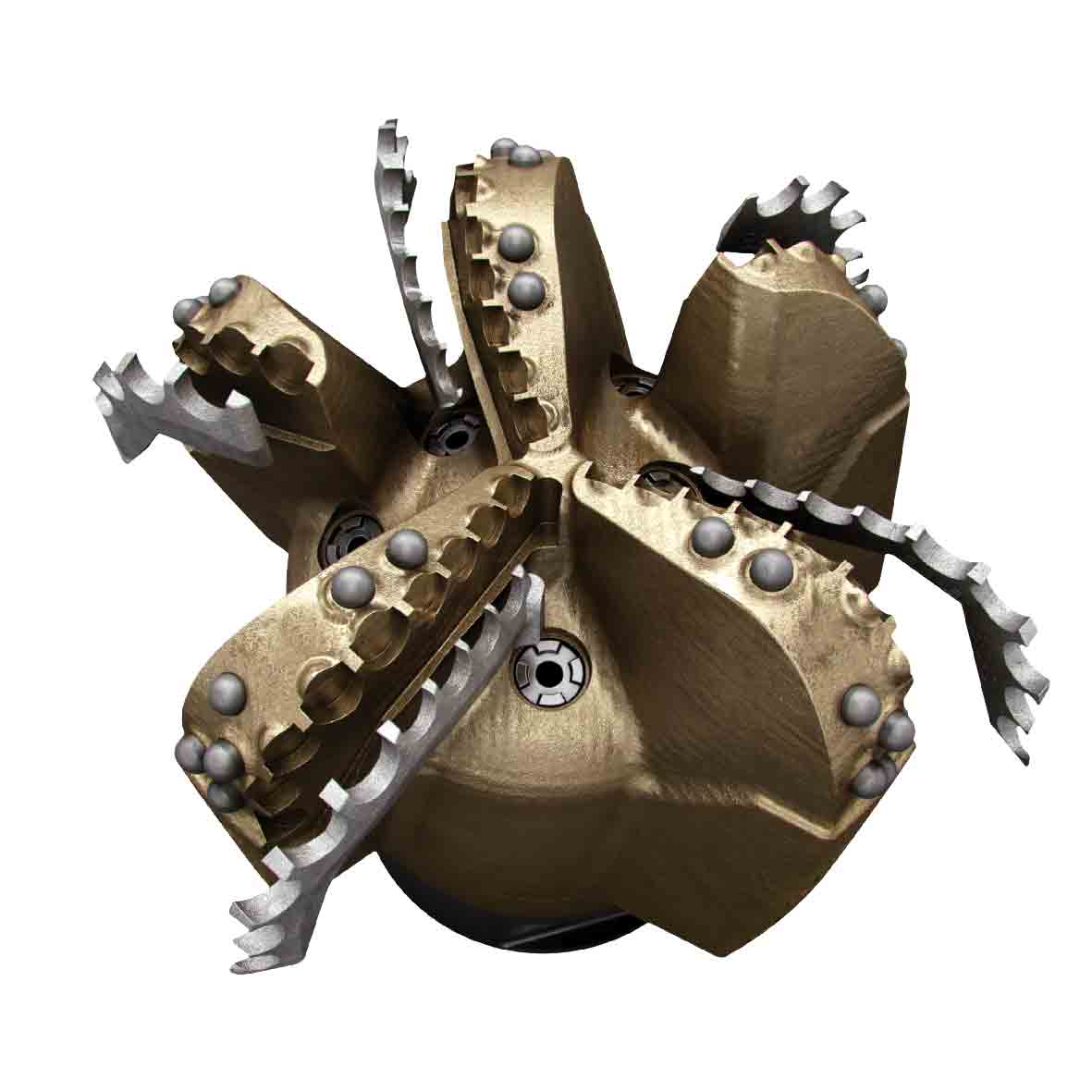
In the polycrystalline diamond compact (PDC) bits market, drillers have the choice of two bit-body options: tungsten-carbide matrix PDC bits and steel-body bits. While steelbody bits incorporate geometries that are more conducive to efficient cuttings evacuation, they are less resistant to erosion when compared to matrix PDC bits. Even with the addition of conventional hardfacing, steel-body bits lack the durability needed to withstand the harsh downhole environments of most drilling applications.
Aegis Armor Cladding comprises individual strips of a tungsten-carbide material applied to the blade face
of steel-body drill bits using an electron-beam additive manufacturing process. Aegis Armor Cladding increases bit erosion resistance by 400% and strength by 40% when compared to conventional matrix PDC bits. This new type of PDC bit construction enables drillers to realize the benefits of steel- and matrix-body bits, so they no longer have to sacrifice drilling performance based on the limitations of conventional bit bodies. Aegis Armor Cladding has undergone extensive field testing, accumulating more than 70 runs worldwide.
DRILLING FLUIDS/STIMULATION WINNER
BAKER HUGHES
DELTA-TEQ LOW-PRESSURE-IMPACT DRILLING FLUID
In challenging offshore wells, pore pressure, fracture gradient and complex geometry combine to create a narrow operating window. Numerous operational problems—such as excessive surge pressures, pressure spikes due to pump initiation pressures, complicated equivalent circulating density (ECD) management and the inability to effectively control drilling parameters—can result in costly and time-consuming events.
Baker Hughes has released the DELTA-TEQ low-pressure-impact drilling fluid, a nonaqueous formulation, to enable operators working in narrow pressure windows to meet their drilling objectives by significantly reducing the risks associated with this activity. The typical solution to drilling in narrow pressure windows has been the use of a low-ECD drilling fluid. The DELTA-TEQ fluid has the ability to manage hydraulic impact by maintaining the right viscosity in the right areas of the well for optimal hole cleaning and penetration rates without putting excess pressure on the formation. Like a “viscosity clutch,” it engages viscosity at low shear rates and disengages at high shear rates.
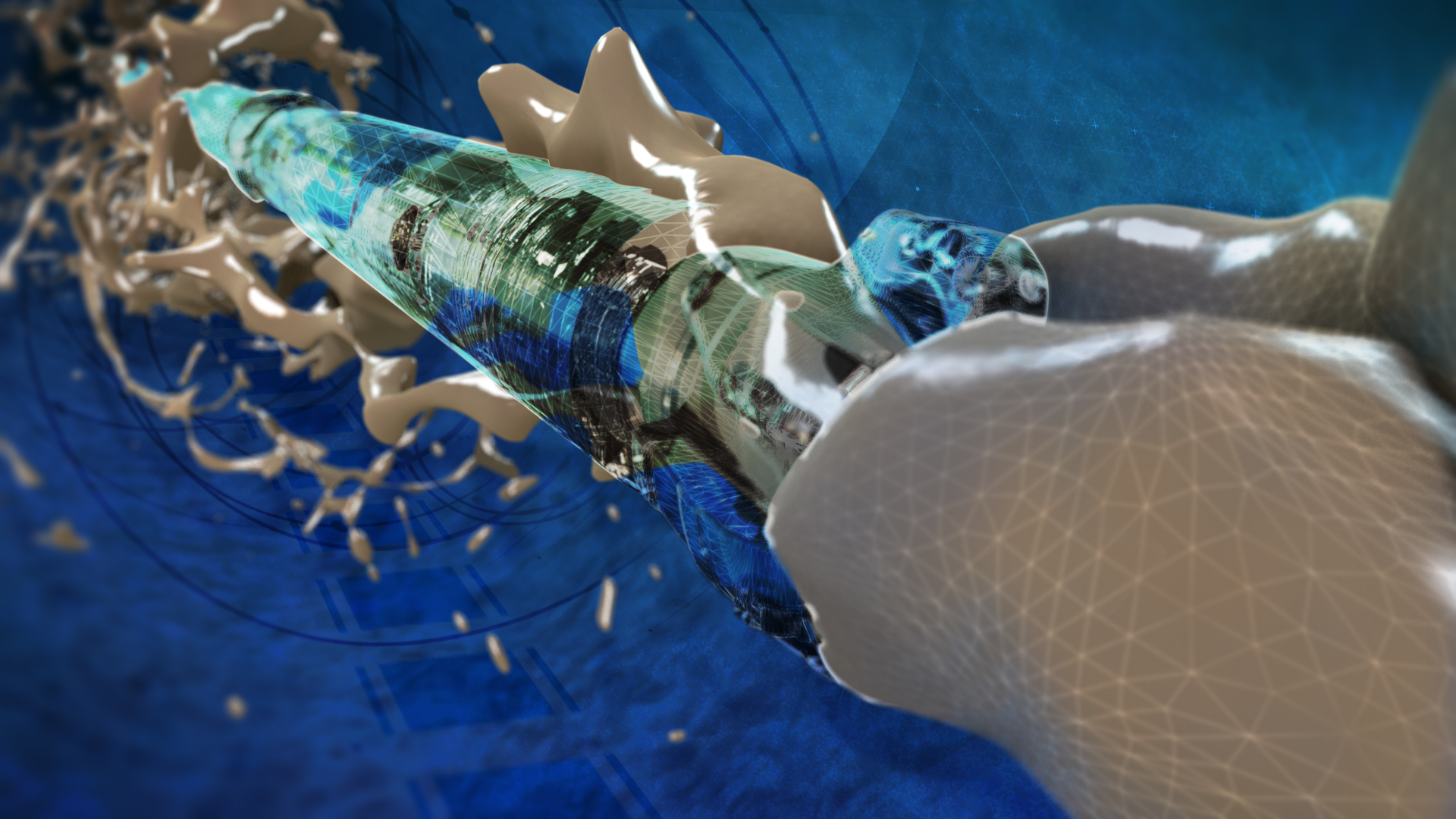
DRILLING FLUIDS/STIMULATION WINNER
TETRA TECHNOLOGIES
TETRA CS NEPTUNE FLUID SYSTEMS
For complex, high-pressure wells, operators need a dense completion fluid system that contains neither zinc nor cesium formate, yet is environmentally sound and commercially viable. Zinc brines are classified as marine pollutants, restricted in the Gulf of Mexico (GoM) and prohibited in the North Sea, Brazil and elsewhere. The cesium salt used in cesium formates is now prohibitively expensive due to depletion of its ore reserves in the world largest mine in Central Canada.
TETRA developed the suite of TETRA CS Neptune completion fluids as an alternative to zinc brines and cesium formate. Meeting environmental regulations for the GoM, North Sea and other regions, the high-density, clear brines have a neutral or alkaline pH and approach the densities of zinc bromide and cesium formate, yet they’re free of zinc, formates and solids.
TETRA CS Neptune fluids can be formulated with densities up to 17.5 ppg and can be blended using standard clear-brine equipment. They are stable at elevated temperatures and during storage. The fluids are compatible with most elastomers and metals, pose low risk of corrosion and can be designed to perform at low temperatures and high pressures without crystallization.
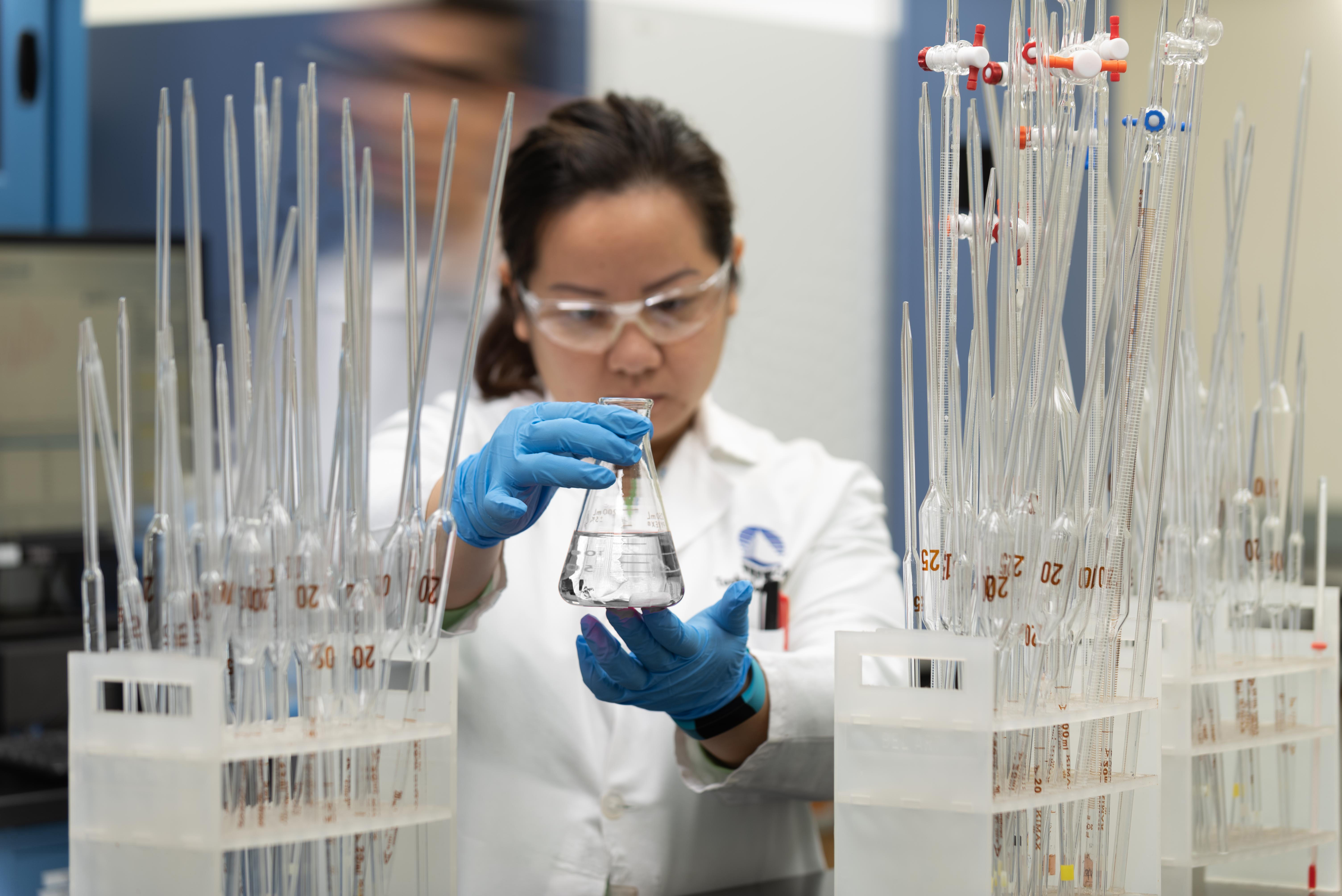
DRILLING SYSTEMS WINNER
GYRODATA
OMEGAX SOLID-STATE SURVEYING SYSTEM

Directional drilling is not always an easy proposition. The challenges inherent in modern wells are many, including multistratigraphic, interbedded rock layers with varying levels of hardness; harsher downhole conditions with higher pressures and temperatures; long laterals and extended-reach drilling applications; and more.
One path to address these challenges involves gyroscopic survey technology. Gyrodata initiated a comprehensive R&D program to develop a solid-state gyroscopic technology that uses an advanced new sensor package to measure the earth’s rotational rate, precisely and accurately determining inclination and true north.
This technology powers the company’s OmegaX system, an all-attitude, solid-state drop gyro surveying system that integrates two independent, three-axis sensor probes. The sensor package and electronics, including memory and data processing, are only 19 inches long, significantly reducing the overall length of the bottomhole assembly. The system can operate to 302 F with no time limitation, making it ideal for use in applications with harsher downhole conditions. OmegaX seamlessly collects surveys during pipe connection, eliminates mass unbalance error and reduces the ellipse of uncertainty by a wide margin versus traditional gyro systems and MWD surveys.
DRILLING SYSTEMS WINNER
WEATHERFORD
AlphaST SINGLE-TRIP OPENHOLE CEMENT AND SIDETRACK SYSTEM
Weatherford’s AlphaST Single-Trip Openhole Cement and Sidetrack System cements, anchors and drills in one trip. This capability saves days of rig time compared to current conventional whipstock systems that require two trips to kick off a sidetrack.
In one trip, the AlphaST system can convey cement, if necessary, anchor the whipstock and immediately kick off a lateral. Instead of using a cement for sidetracking, the system uses a packer, which eliminates re-cementing and redrilling operations associated with plug failure. The system also enables drilling past a fish, straightening crooked holes and bypassing collapsed boreholes. The system consists of an injection production packer (IPP), which takes the place of a cement plug for anchoring purposes. The IPP anchor enables positioning the lateral departure in the openhole wellbore without the need for a false bottom or cement barrier. The system also incorporates a specially designed flow tube, a low-angle whipstock and a twin-mill drilloff bottomhole assembly (BHA). The flow tube conveys cement to create a barrier in the original wellbore. The single-angle 3-degree whipstock creates a smooth transition into the sidetrack without steps or ledges, which enables the use of drilling BHAs with short-tooth or polycrystalline diamond compact style bits.
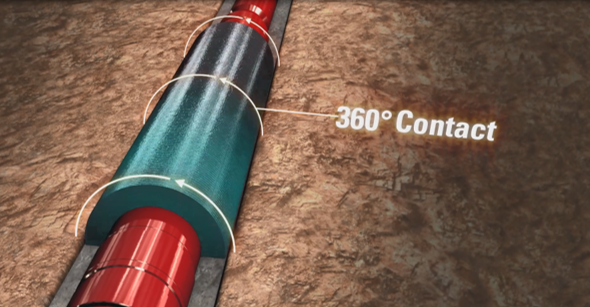
EXPLORATION/GEOSCIENCE WINNER
SAUDI ARAMCO
SPICERACK
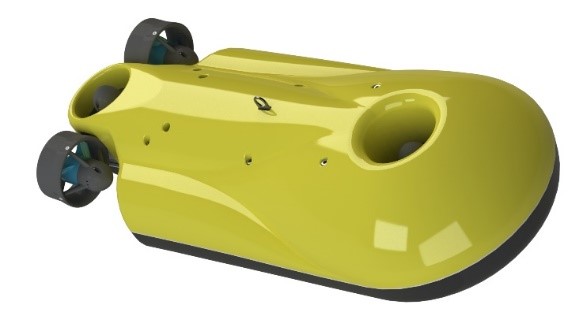
Saudi Aramco’s SpiceRack is a multiyear research collaboration project with EXPEC ARC and Seabed GeoSolutions to design, develop, manufacture and commercialize a highly productive, fully robotized and cost-efficient solution for seafloor seismic acquisition. This type of seafloor acquisition incorporates robotized AUVs for the deployment, recording and retrieval of seismic seafloor sensors.
Conventional seafloor seismic acquisition is using seismic sensors positioned on the seafloor that are either attached to cables/ropes or are cableless nodes. For the cable type deployment and retrieval, multiple vessels are required, making the cost of these type of surveys prohibitively expensive. For the deployment and retrieval of nodal sensors, an ROV is required, increasing the total duration of such surveys and thus increases significantly acquisition costs.
Alternatively, SpiceRack is a disruptive technology that uses robots and automation for the deployment and retrieval of AUVs as seismic sensors. By automating seafloor acquisition, a cost reduction of 30% and increase in productivity of 50% is expected. SpiceRack, by using automation and robots, creates a more efficient and safer operation to produce high-resolution subsurface images.
FORMATION EVALUATION WINNER
HALLIBURTON
EARTHSTAR ULTRA-DEEP RESISTIVITY SERVICE 3D INVERSION
Halliburton’s EarthStar Ultra-Deep Resistivity Service 3D Inversion makes electromagnetic field measurements around the borehole while drilling and converts them into a 3D model of the geological structure using an advanced, mesh-based, computational inversion method. The 3D model of the reservoir allows operators to see a realistic representation of the true reservoir structure, which helps them to make informed well-placement decisions and obtain a far better understanding of the shape, size and productivity of the reservoir. The EarthStar service illuminates and maps reservoir and fluid boundaries, with a proven capability to map these features up to 225 ft from the wellbore, extending the sensitive range up to 10 times farther than was previously possible.
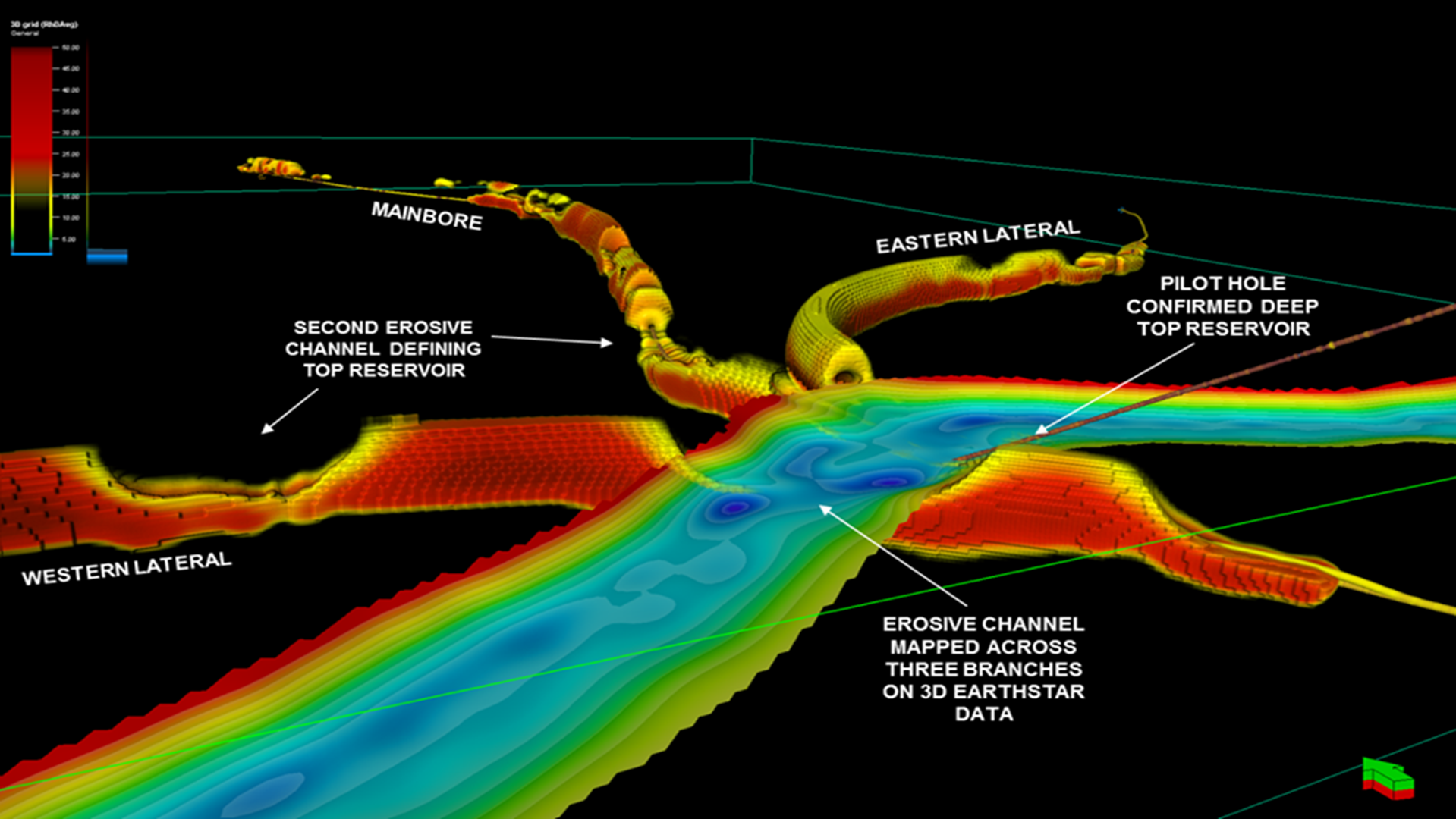
FORMATION EVALUATION WINNER
WEATHERFORD
INTELLIGENT CONVEYANCE SYSTEM
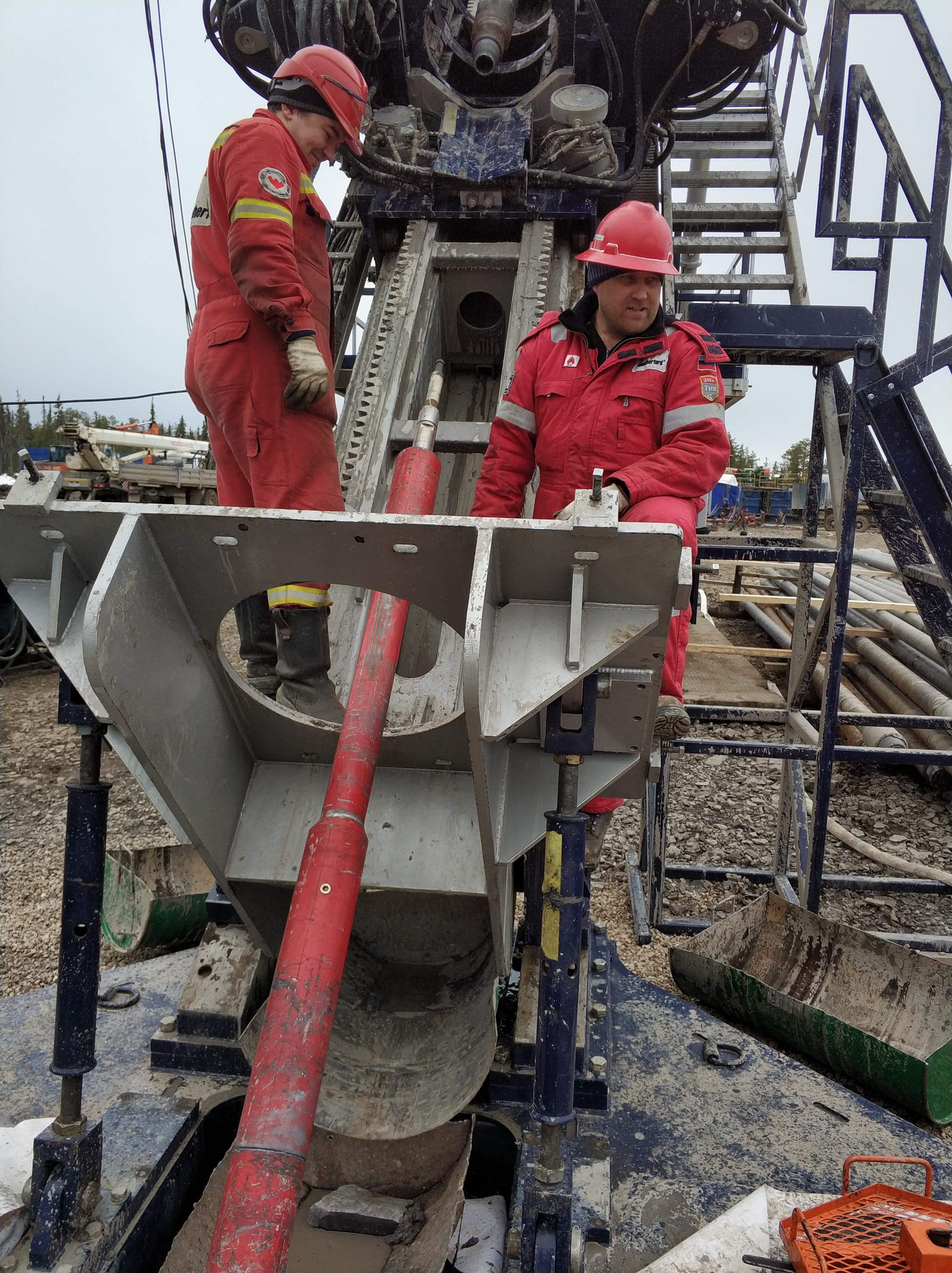
The Weatherford Intelligent Conveyance System (ICS) advances autonomy and communication in openhole logging to improve operational outcomes. Designed to convey Compact logging tools to total depth (TD), the ICS applies to horizontal wells, slant rigs and remote locations.
Currently, most openhole logging jobs use a hydromechanical system. Although highly reliable with very few failures and a greater than 95% operating efficiency, the hydromechanical approach lacks two-way communication between the engineer at the surface and the downhole tools. The ICS was designed to provide the same reliability while improving on tool communication and memory capabilities. The ICS uses two-way communication, including drillpipe rotation to communicate to the downhole tools and pressure pulses to reply for the uplink. The other ICS differentiator is the downhole memory sub that acts as a logging robot that autonomously sends out commands to open the caliper, record data, communicate with the surface and mitigate potential fault conditions for more reliable log acquisition. The memory sub divides tasks into two different levels according to the level of intelligence needed.
HSE WINNER
CRUSOE ENERGY SYSTEMS INC.
DIGITAL FLARE MITIGATION
The Digital Flare Mitigation (DFM) system by Crusoe Energy Systems Inc. deploys modular, mobile, energy-intensive data centers directly to well sites to consume natural gas that would otherwise be wasted through flaring. Scalable to millions of cubic feet per day at each location, the system provides a badly needed beneficial use for associated gas, facilitates regulatory compliance with gas capture requirements and achieves a 30% to 40% reduction in CO2-equivalent greenhouse-gas emissions, plus significant air quality and visual impact improvements versus open flaring. DFM systems are commissioned in a matter of days and can remobilize to new sites as gas volumes decline through well maturation. Relative to other flare mitigation technologies, Crusoe’s system represents a complete and scalable solution for the operator’s associated gas stream that is economically attractive. In many cases, the DFM system is delivered at low or no cost. For projects with sufficient scale, term and supply redundancy, Crusoe can provide gas revenue to operators where no revenue existed before, while simultaneously delivering critical regulatory and environmental compliance value.
Crusoe installed the first DFM system in the Powder River Basin of Wyoming in January 2019 and grew to 10 deployments over the following year. Each of Crusoe’s deployments helps an upstream operator reduce natural gas flaring in the field and simultaneously provides a low-cost energy source for compute processes running in Crusoe’s data centers.
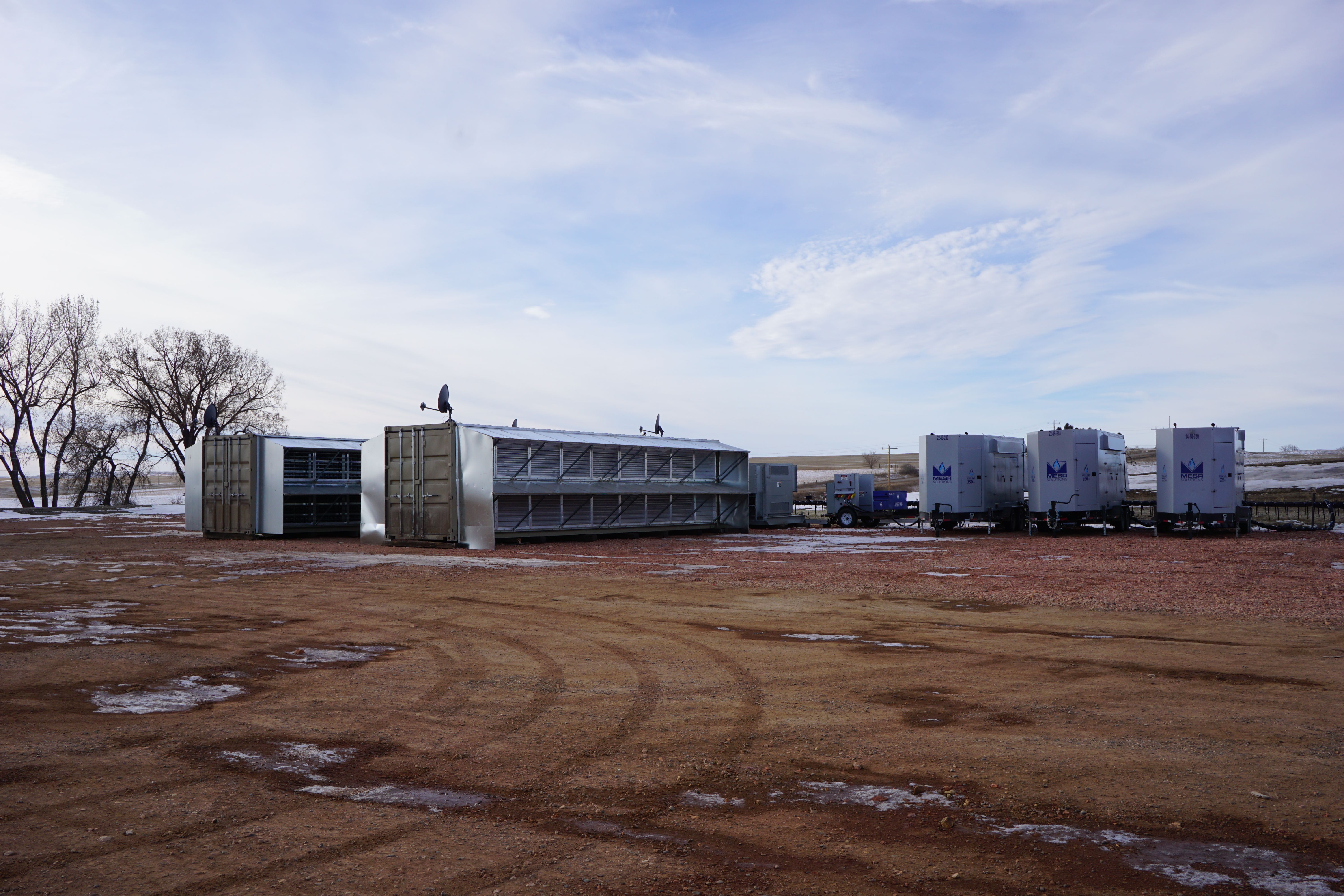
HSE WINNER
FRANK’S INTERNATIONAL
RACK BACK CONSOLE
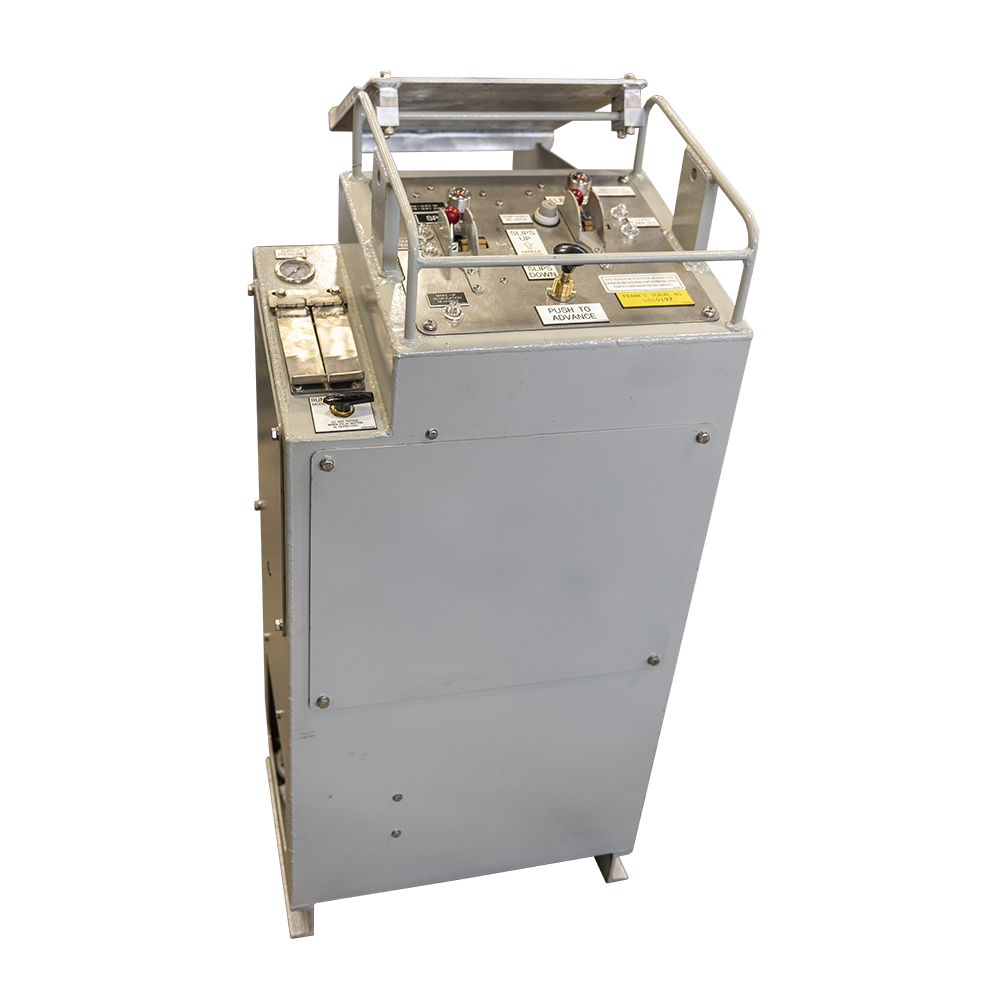
To reduce the risk of dropped joints or stands of pipe during rack back operations, Frank’s International has developed the Rack Back Console, a specialized control console designed to control pneumatic elevators and spiders building double, triple or quad stands for racking back in the derrick. Although these programmed functions can be controlled electronically, mechanical programming with pneumatic logic allows working on the rig floor without the need for costly hazardous area certifications. The Rack Back Console programming will allow only the correct tool (elevator or spider) control valve to be activated at each operational step of the tubular stand building process, thereby preventing the tool from being activated out of operational sequence. The Rack Back Console automatically resets each stand building cycle based on the number of steps required to complete a double, triple or quad tubular stand. It also includes both run and pull modes for building and laying out stands. This feature allows the operation sequence to be reversed in the event the tubular stand must be disassembled.
The Rack Back Console was first successfully deployed in January 2019 to rack back a variety of stands on a multiwell project for a major operator on a dual-activity drillship in the Gulf of Mexico. The Rack Back Console successfully ran more than 180 stands with several wells.
HYDRAULIC FRACTURING/PRESSURE PUMPING WINNER
BJ SERVICES
THINFRAC MP FRICTION REDUCER

BJ Services’ ThinFrac MP friction reducer is a fluid solution for the effective extraction of hydrocarbons from unconventional reservoirs. It is designed to provide pumping efficiency, complex fracture networks and precise breakability to increase production and improve operational efficiencies.
ThinFrac MP is a cost-effective polyacrylamide polymer friction reducer with superior proppant-carrying properties. This synthetic engineered polymer provides rapid hydration in 8 to 10 seconds, delivering instantaneous friction reduction. Due to its viscoelastic properties, it provides superior proppant transport capabilities in slickwater fracturing operations to deliver the proppant to the fractures. Because of its high molecular weight and rapid hydration, it delivers greater pipe friction reduction at lower loading.
Operators have seen as much as 85% reduction in pipe friction pressure, which has proven to lower hydraulic horsepower and surface equipment requirements. The polymer friction reducer is compatible with freshwater, brines and low-pH fluids.
HYDRAULIC FRACTURING/PRESSURE PUMPING WINNER
NINE ENERGY SERVICE
BREAKTHRU CASING FLOTATION DEVICE

Nine Energy Service’s BreakThru Casing Flotation Device is a technologically advanced barrier designed to float casing across long lateral runs to the toe of the wellbore.
BreakThru works by running casing to a predetermined depth based on wellbore modeling using two fewer connections and two fewer thread sets than conventional casing flotation devices. Then fluid is pumped into the casing above the barrier, creating the force necessary to push the casing all the way to target depth.
Once the casing is fully landed, additional fluid accumulates until it reaches the activation pressure needed to disintegrate the barrier into fine, sand-like particles.
These fine particles are easily circulated out through sleeves, toe valves and float equipment, eliminating the need for a debris trap, fluid flushes or extra trips to retrieve device pieces.
As a result, operators can begin pumping cement immediately, saving time and generating increased efficiencies. BreakThru’s durability provides a reliable seal under the extreme temperatures and axial loads encountered during run-in, yet reliably shatters once the casing is landed.
INTELLIGENT COMPONENTS WINNER
HALLIBURTON
IMERSIV AUGMENTED AND VIRTUAL REALITY SOLUTIONS
Conventional offshore rig site surveys typically take weeks. With the new Imersiv Augmented and Virtual Reality Solutions from Halliburton, operators can save at least two days of rig time and improve the accuracy of rig surveys and audits for offshore solids control and fluid management. Using a Microsoft HoloLens, users can digitally overlay precise 1:1 scale 3D models of equipment onto existing physical rig spaces while concurrently performing high-resolution scans of the respective rig space and access routes. This combination delivered by Imersiv Augmented and Virtual Reality Solutions enables users to promptly identify obstacles that can impede installation and ensure the selected equipment conforms to the operator’s rig design and processing requirements in real time, increasing levels of confidence. Survey experts no longer have to travel across time zones to a rig, which could add days or weeks of nonproductive time (NPT) and significant cost overruns. Now these same specialists can provide remote survey assistance to multiple operations in different parts of the world, without ever having to leave their office. The end result is lower operating costs, reduced headcount, less NPT and lower risk.
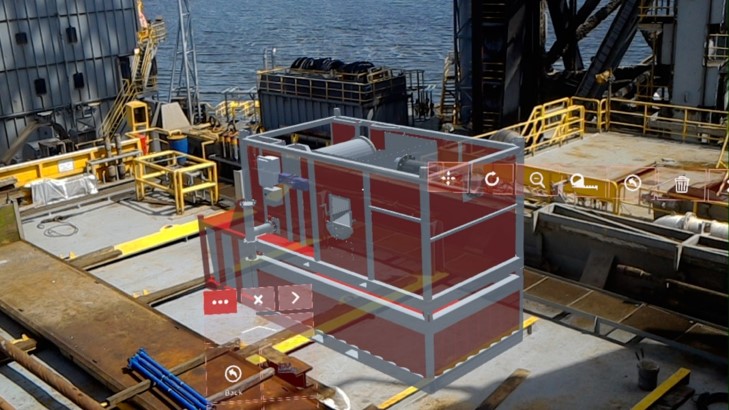
INTELLIGENT COMPONENTS WINNER
SIEMENS
ADDITIVE MANUFACTURING FOR FOSSIL-FREE COMBUSTION IN GAS TURBINES
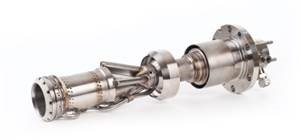
As a fuel source, hydrogen is well positioned to meet the market demands for low-emission gas turbines with dry low emission (DLE) combustion systems. The turbines incorporate the latest generation of DLE burner, which efficiently burns hydrogen or hydrogen/fuel gas mixes to lower CO2 and NOx emissions. In recent years, the development effort has been accelerated by incorporating additive manufacturing (AM) techniques to enable rapid design, prototyping and manufacturing. Prototypes produced by AM are delivered faster than by conventional manufacturing, which makes testing of different components more efficient and reduces testing and development time by as much as 75%. AM also delivers 60% faster repairs of components like burner tips, 40% to 50% lower lead times for spare parts and complete burner sets, and an essentially limitless flexibility in the design of new parts.
Siemens’ medium-size gas turbines run on a wide range of fuel specs. The model SGT-800 gas turbine runs with up to 50 vol-% H2 in the fuel mix, the SGT-700 with up to 55 vol-% H2 and the SGT-600 with up to 60 vol-% H2. The ultimate goal of delivering a 100 vol-% H2 is closer to realization, thanks to promising test results of a single burner operating on 100 vol-% H2 in Siemens Clean Energy test center in Berlin.
INTELLIGENT COMPONENTS WINNER
U.S. WELL SERVICES
POWER PATH
U.S. Well Services’ (USWS) PowerPath provides 13,800-volt electrical power to remote pads that can be several miles away from the turbine generator. This advancement in technology allows the turbine to rig into one location and feed the electricity to multiple pads using a micro-grid, therefore decreasing the mobilization time between pads. This micro-grid and centralized location for the turbine also eliminates the need for each pad from having existing field gas pipelines to it before the wells are stimulated or having to truck CNG or LNG to each location during the frac job. PowerPath is not limited to only frac operations. Operators can utilize PowerPath to power other oilfield equipment such as drilling rigs when developing acreage within a concentrated area. USWS first deployed the PowerPath technology in June 2019 to successfully provide power to a remote hydraulic fracturing operation 2.5 miles away. The technology allows power generation to be centrally located among five hydraulic fracturing pads and to transmit power miles away via overhead lines to onsite Clean Fleet pumping equipment. Utilizing high-voltage electricity allowed the power to be sent multiple miles without power losses that come from low- and medium-voltage systems.
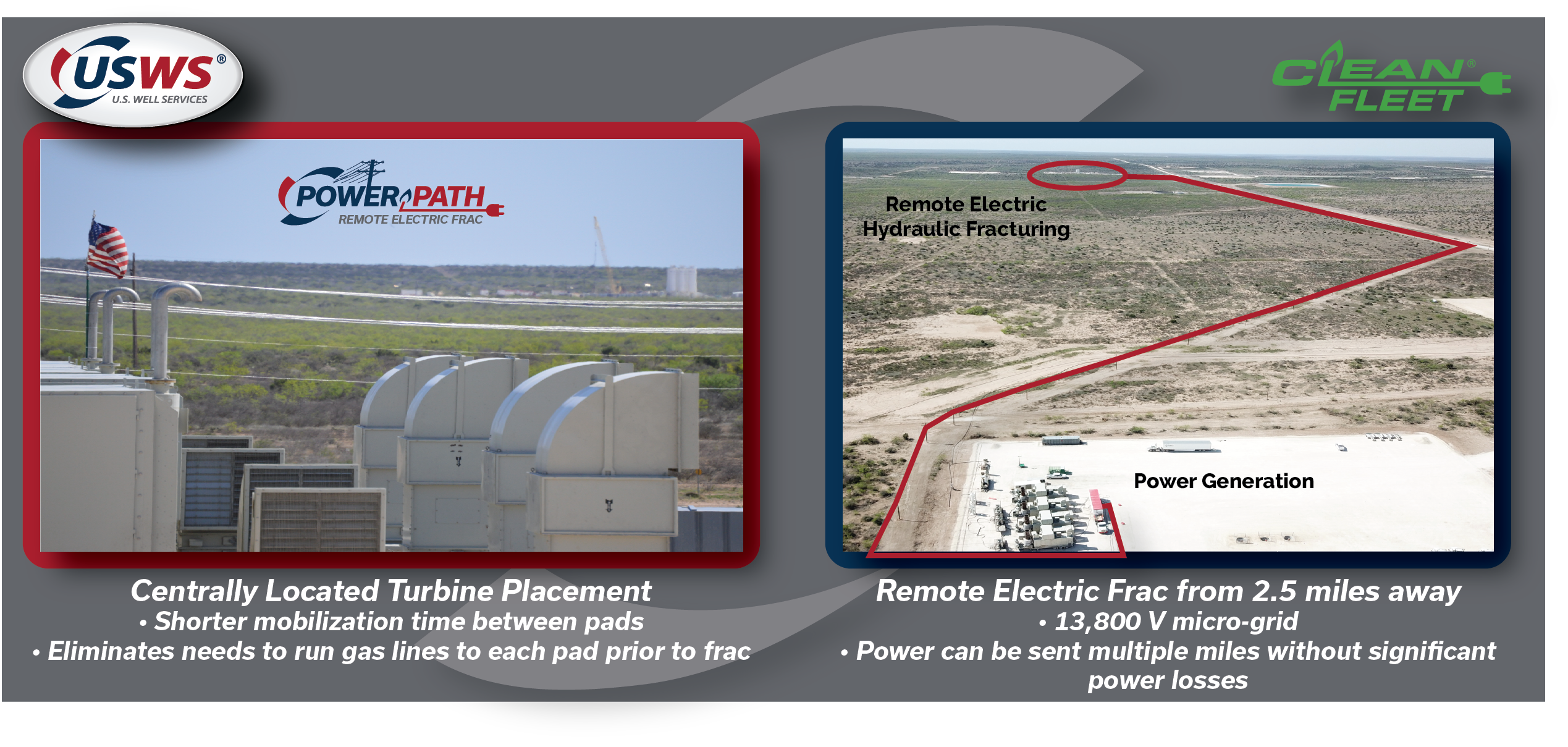
INTELLIGENT SYSTEMS WINNER
BEDROCK AUTOMATION
BEDROCK OPEN SECURE AUTOMATION
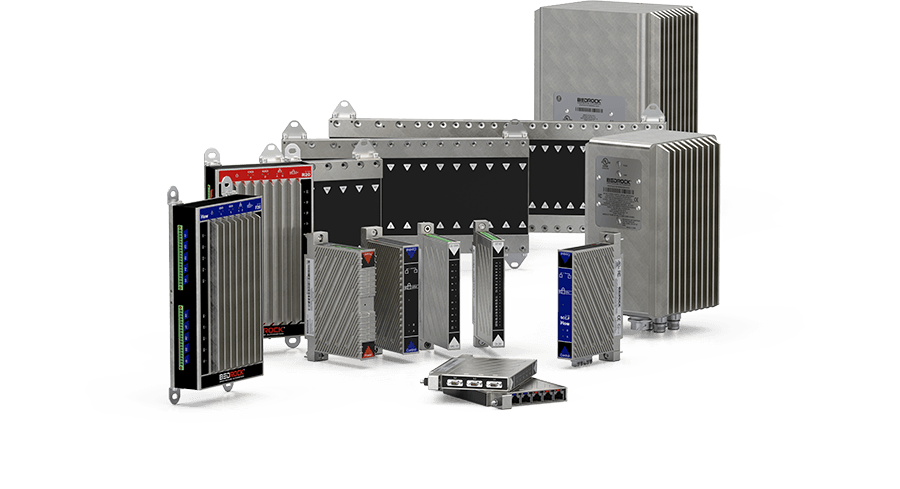
Bedrock Open Secure Automation (OSA) is a high-capacity control system with built-in cybersecurity. The authentication and encryption capabilities that had previously been available only in military and aerospace electronics are embedded into Bedrock’s control system platform. To overpower this digital efense-in-depth, rogue code would have to pass through numerous authentication and encryption steps occurring in real time on all parts of the system electronics. This is not a practical possibility. The modules are further protected against cyber intrusion by encasement in sealed anti-tamper metal and a pin-less backplane, which also delivers extreme electromagnetic and thermal hardening for real-world reliability. OSA encompasses PLC, RTU, DCS and EFM capabilities, but it augments them with the cybersecurity and higher performance necessary to remain competitive. By making security built-in, Bedrock OSA has removed the cost of cybersecurity as a barrier to deploying IIoT architectures.
INTELLIGENT SYSTEMS WINNER
DATA GUMBO CORP.
GUMBONET
Data Gumbo Corp.’s GumboNet blockchain-based network automates smart contracts and transactions for industry leaders by utilizing the combination of distributed ledger technology with contract terms confirmed with operating field data. In providing a single, industry-agnostic immutable record of truth across participants, GumboNet solves long-standing issues of trust and data inaccuracies to reduce barriers associated with doing business. By forging trust between stakeholders, automating transactions and mitigating contract leakage, GumboNet is significantly changing how businesses transact. Old World business methodologies often include processes modeled on paper trails, isolated corporate views, rigid IT infrastructure, siloed systems, enterprise resource planning and transactional friction. With Data Gumbo, this approach is replaced by operational transparency, contractual flexibility and frictionless transactions. As a simple, intuitive and subscription-based blockchain network, companies are freed from building and sustaining standalone, siloed blockchain technologies that require resources and continuous oversight.
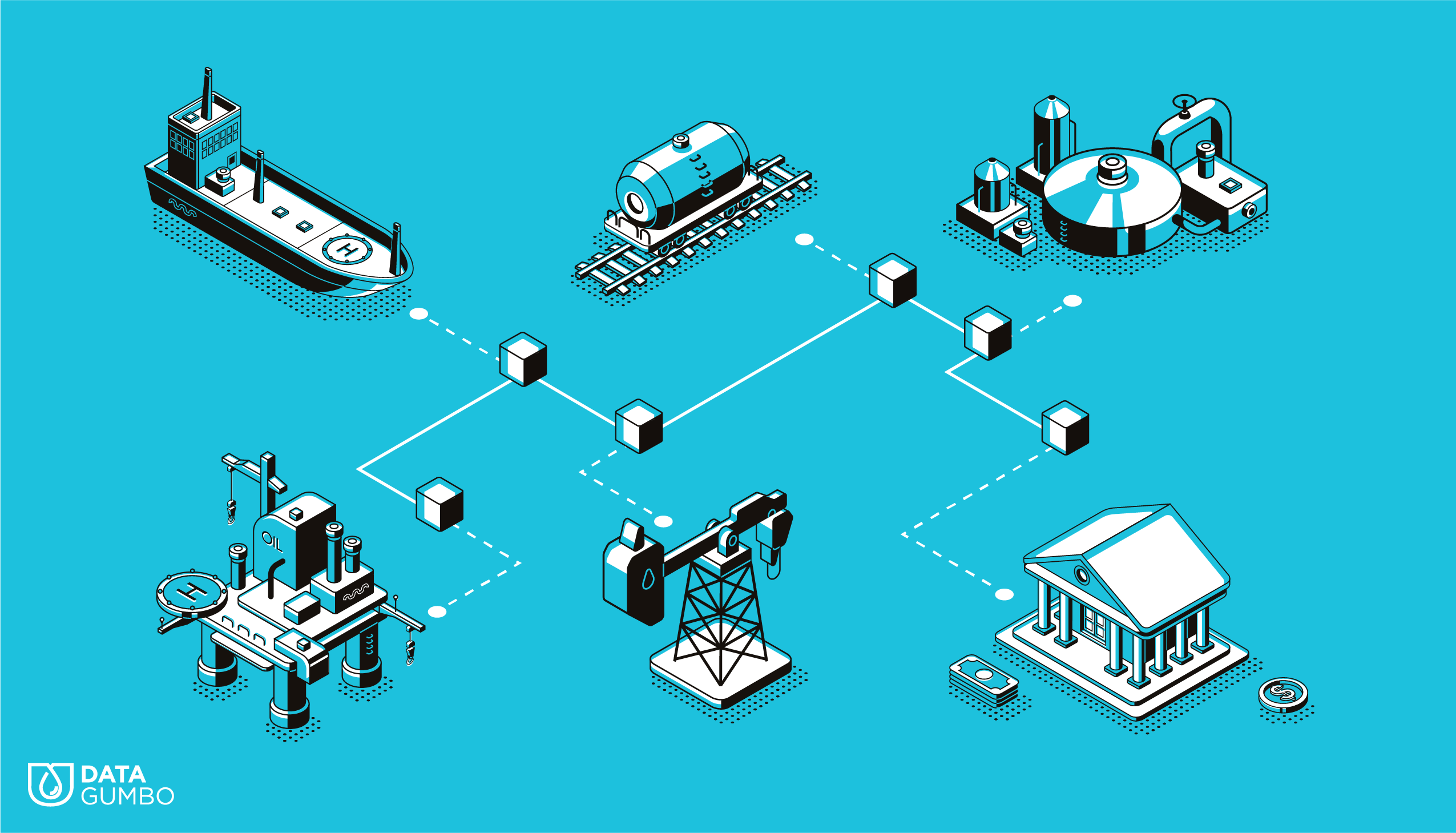
IOR/EOR/REMEDIATION WINNER
SAUDI ARAMCO
NANO-ENCAPSULATED RESERVOIR CHEMICAL TREATMENTS
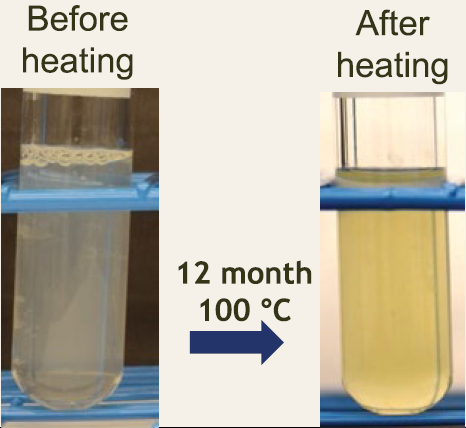
More than 50% of hydrocarbon resources in subsurface reservoirs are unrecoverable by current operations. Chemical EOR is one of the most promising and widely studied methods to help recover remaining hydrocarbons. Successful EOR formulations need to be low cost and accessible
at large quantities.
Saudi Aramco has developed a nano-surfactant technology that offers a one-step highly economic process for stabilizing and target-delivering hot brine-incompatible surfactants. The developed nano-encapsulation technique extends the use of a large variety of reservoir chemical treatments that are otherwise inoperative in high salinity and temperature reservoirs. At the same time, it improves their performance and depth of penetration as well as reduces the amount of chemicals needed without affecting performance. The method was inspired by formulations widely used in nanotechnology for medicine and successfully translated into the oil field by a multidisciplinary team of scientists and engineers. Studies demonstrated that this method of nano-encapsulation of surfactants represents one of the industry’s first formulations that can be scaled up and synthesized in the field, can be used for various applications in reservoirs with various salinity and temperature brines, and provides high-efficiency mobilization of the remaining oil.
IOR/EOR/REMEDIATION WINNER
WELL-SENSE
FIBERLINE INTERVENTION SYSTEM
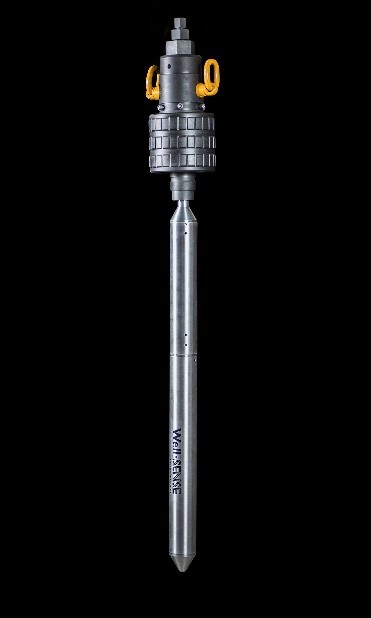
Well-SENSE’s FiberLine Intervention (FLI) System is designed to deliver faster, smarter well intelligence. The technology has demonstrated efficiency gains and the rapid acquisition of high-quality, richer downhole data compared to conventional wireline methods. FLI is a self-contained, portable system using a pressure containing “launcher” connected to the wellhead. It deploys the probe into the well, which lays bare optical fiber to total depth. The fiber gathers instant, distributed data simultaneously across the entire length of the fiber-optic cable. Temperature and acoustic profiles can be captured, plus any changes over time, resulting in a rich picture of the complete well. As it does not rely on wireline, slickline or coiled tubing for deployment, results are obtained faster, more economically, using less personnel with reduced wellsite personnel on board, footprint and operational risk. FLI operations on average can take up to 3 hours of logging, compared to up to 24 hours for single-point wireline logging.
Just one Well-SENSE engineer is required to transport and operate FLI. Its lightweight, compact size means it is delivered to the well site in the back of a truck or via a small shipping box. This opens up new opportunities, allowing operators to acquire data from more challenging, less accessible wellsite locations, such as unmanned offshore satellite platforms with little or no deck space.
As a plug-and-play system, FLI is ready for rapid implementation. It takes just one person about 30 minutes to an hour to rig up, while rigging down is almost immediate. The probe is sacrificial or retrievable depending on the client’s preference. Compared with onshore data acquisition in the U.S., FLI could offer up to 50% to 75% cost savings, whereas this can potentially reach 90% in the offshore environment, depending on the application.
MARINE CONSTRUCTION & DECOMMISSIONING WINNER
SCHLUMBERGER
CEMFIT HEAL FLEXIBLE SELF-HEALING CEMENT SYSTEM
Schlumberger’s CemFIT Heal flexible self-healing cement system helps ensure well integrity from drilling to abandonment, providing a competent annular pressure seal and protecting against hydrocarbon leaks and sustained casing pressure (SCP). Using the CemFIT Heal system eliminates SCP at the construction phase and minimizes risks and operational challenges at decommissioning. Conventional cement systems expand after setting only in the presence of water coming from the formation; however, these systems cannot self-heal subsequently if the cement matrix is damaged. The CemFIT Heal system heals upon interaction with hydrocarbons, improving cement bonding and sealing
micro-annuli that can cause unwanted gas migration. A low Young’s modulus enables it to withstand cement sheath stresses from drilling, perforating, stimulation treatments, and temperature and pressure changes, which help prevent cement sheath failure.
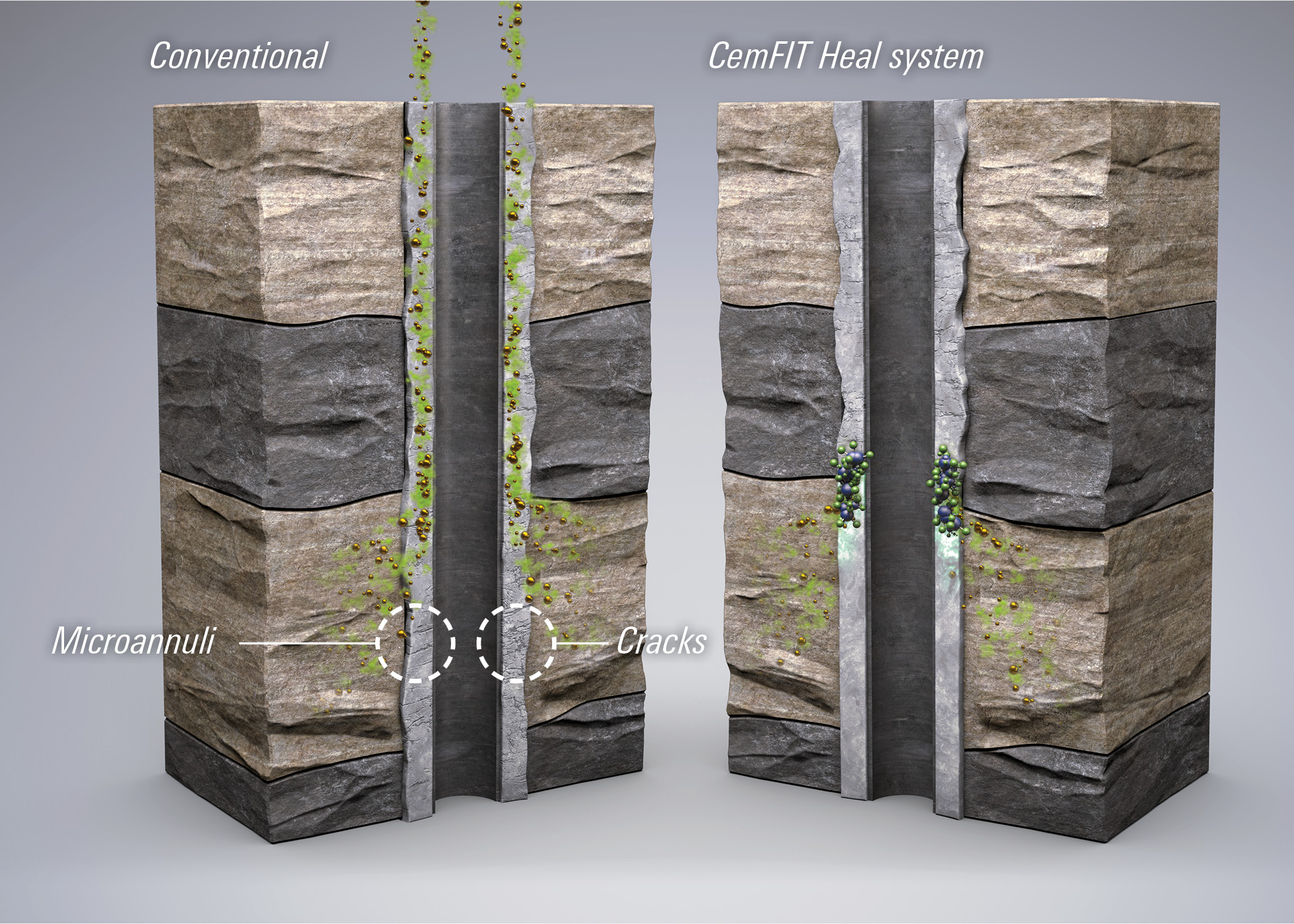
SUBSEA SYSTEMS WINNER
SCHLUMBERGER
CASING RECONNECT METAL-TO-METAL, GAS-TIGHT CASING REPAIR SYSTEM
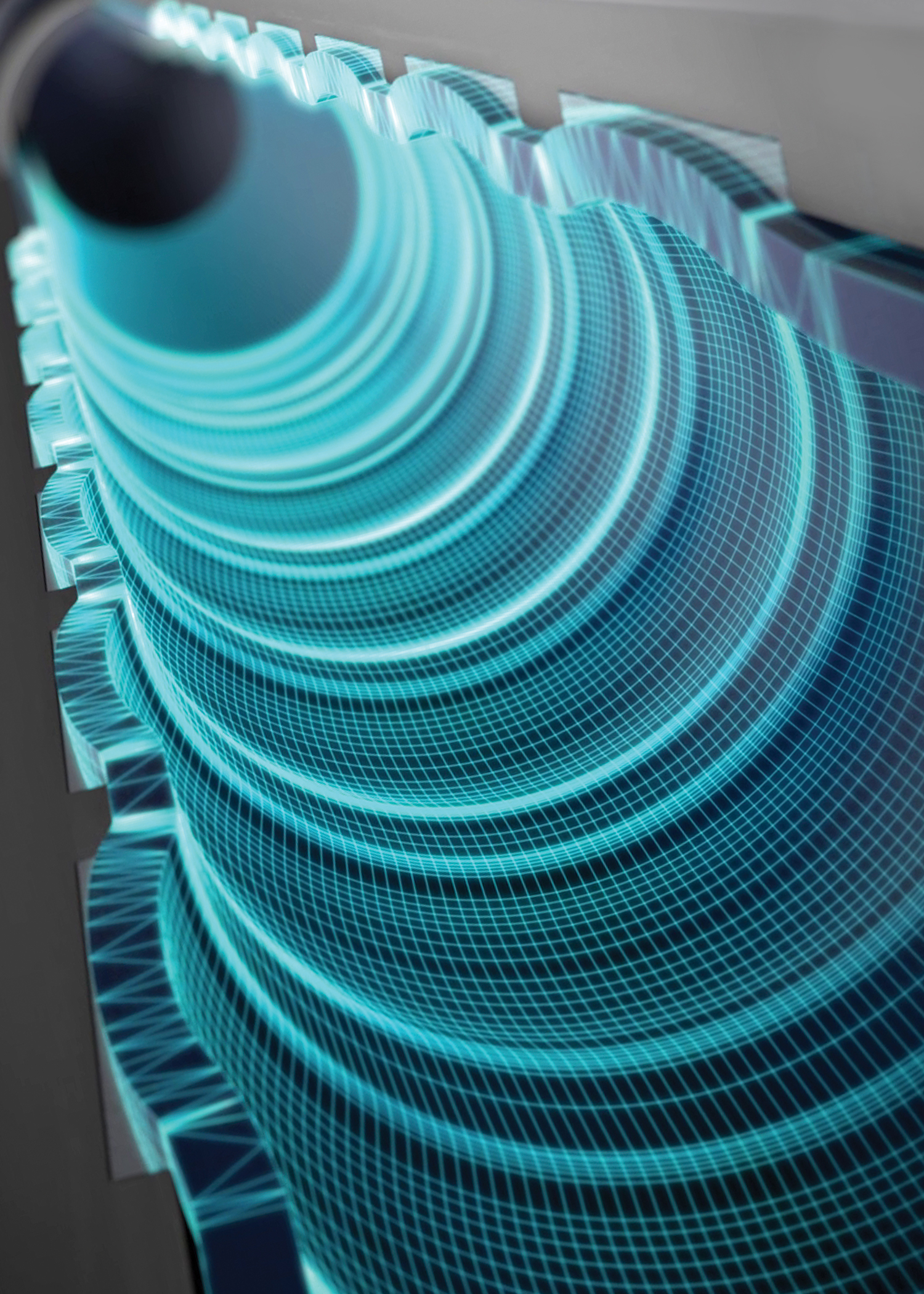
Schlumberger’s Casing Reconnect Metal-to-Metal, Gas-Tight Casing Repair System is a cost-effective remediation system for well operations. The system seamlessly replaces stuck or damaged casing and provides a robust seal for the life of the well, keeping drilling programs on schedule and securing well integrity for plugging and abandonment operations. The Casing Reconnect system enables cutting and pulling casing anywhere between the wellhead and the stuck point. Replacement casing is then run with a Casing Reconnect system to the receptacle on the bottom—correctly spaced out with the casing hanger. The casing stump is then morphed into the Casing Reconnect system receptacle to rejoin the two strings with a high axial-load-bearing, metal-to-metal seal. The system accommodates excess swallow at the connection, simplifying space out for correctly landing the hanger. The system is ISO 14310 VO-rated and contains no moving parts. The full-axial-load-bearing reconnection tool uses Metalmorphology metal-to-metal sealing and anchoring technology.
SUBSURFACE COMPLETIONS WINNER
DEEP IMAGING
DEEP IMAGING REAL-TIME FLUID TRACKING
E&Ps were successful at developing highly productive well designs and then inadvertently spaced them too closely together. Despite technological advancements, teams can’t precisely evaluate how much rock was treated during a frac, nor can they effectively identify completions issues and whether they were successful in mitigating them. Deep Imaging offers a real-time system for tracking fluid as it’s pumped through the wellbore and out to the fracture tips during a completion job. While seeing stages form in real time, operators are validating models and successful stages while identifying, fixing or avoiding problem stages as they occur. By spotting issues at inception, companies are reducing waste and boosting well productivity. Lookback efforts to improve well models are important, but well inventories are too valuable to make adjustments solely on the next well. In one example, a customer discovered how to save up to $1 million on future wells by reducing the number of frac stages per well without impacting performance.
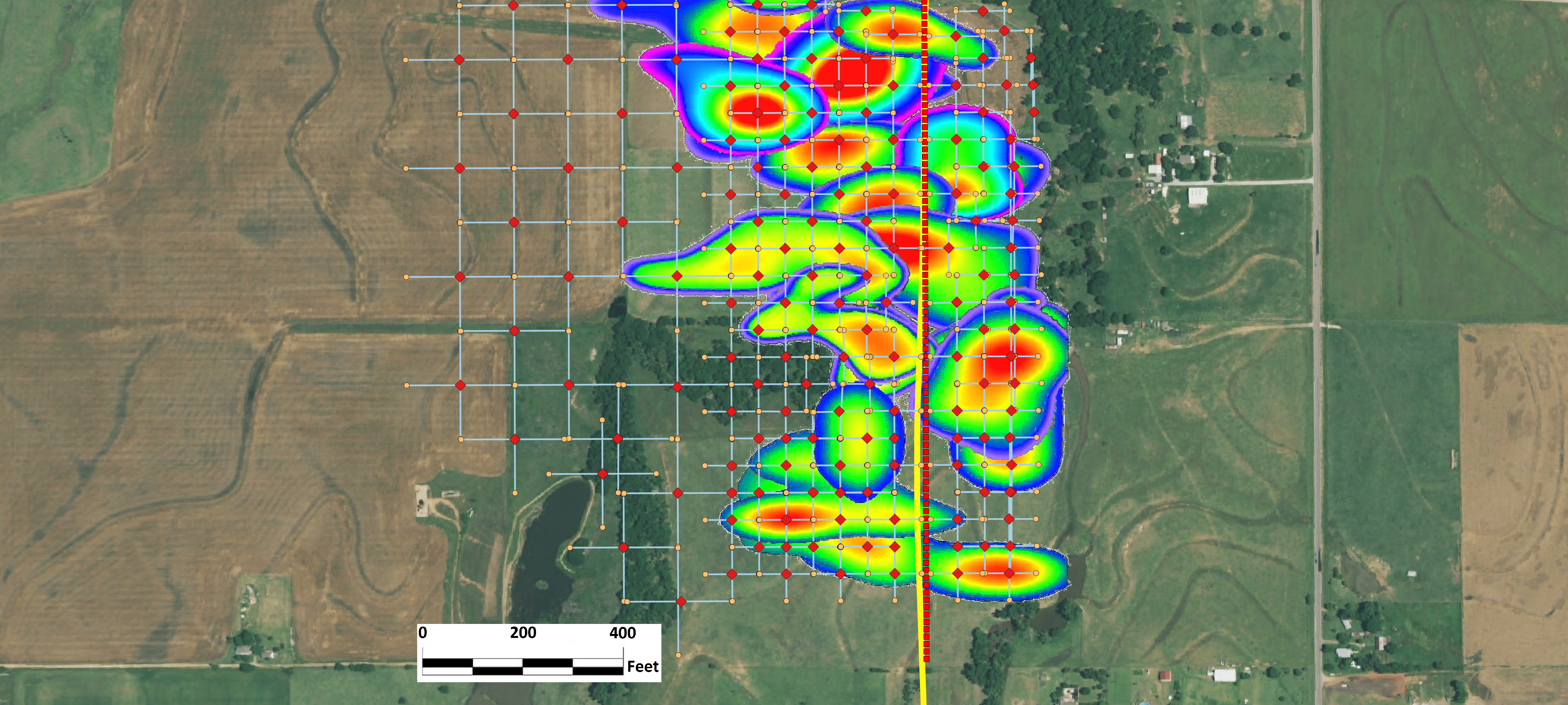
WATER MANAGEMENT WINNER
SAUDI ARAMCO
ACOUSTIC OIL-WATER-FINES SEPARATION
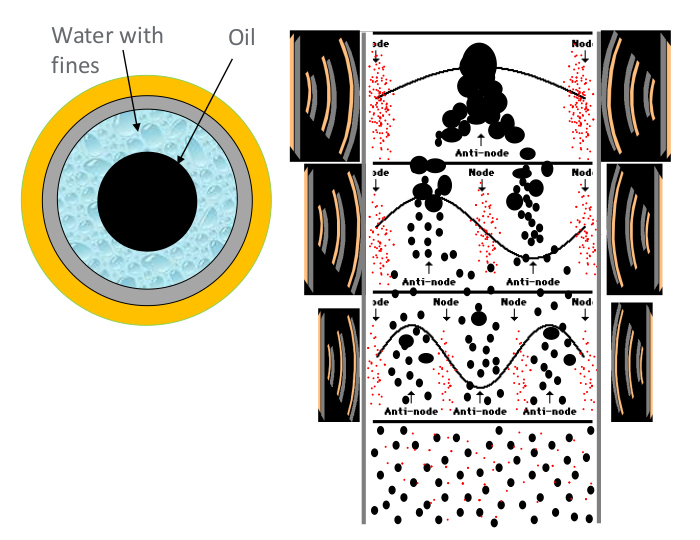
Saudi Aramco’s Acoustic Oil-Water-Fines Separation system separates minute amounts of small oil droplets and solid particles from flowing fluid streams without intervention. The three-phase separation technology can be used to reduce the volumes of water produced from mature oil and gas reservoirs and pumped to the processing plants by several orders of magnitude. It reduces the costs for pumping and treating massive volumes of produced water as well as the health and environmental hazards associated with handling large volumes of produced water. Because of its ability to separate minute volumes of oil and particles, the technology can be utilized in treating produced water prior to injection into the disposal wells, reducing the risk of contaminating groundwater aquifers. The acoustic separation tool increases the oil-to-water ratios in producing wells and also reduces the risk of pore clogging and formation contamination should water be reinjected back in the formation. The tool also can be utilized as a surface separation system to reduce the volume of produced water prior to reaching the gas-oil separation plant (GOSP), thus costs of reconfiguring the GOSP to accommodate increased water cuts.
Enter your new technology into the MEAs competition by Jan. 31, 2021. Entry is free!
Recommended Reading
Excelerate Energy, Qatar Sign 15-year LNG Agreement
2024-01-29 - Excelerate agreed to purchase up to 1 million tonnes per anumm of LNG in Bangladesh from QatarEnergy.
UK’s Union Jack Oil to Expand into the Permian
2024-01-29 - In addition to its three mineral royalty acquisitions in the Permian, Union Jack Oil is also looking to expand into Oklahoma via joint ventures with Reach Oil & Gas Inc.
Permian Resources Continues Buying Spree in New Mexico
2024-01-30 - Permian Resources acquired two properties in New Mexico for approximately $175 million.
Eni, Vår Energi Wrap Up Acquisition of Neptune Energy Assets
2024-01-31 - Neptune retains its German operations, Vår takes over the Norwegian portfolio and Eni scoops up the rest of the assets under the $4.9 billion deal.
NOG Closes Utica Shale, Delaware Basin Acquisitions
2024-02-05 - Northern Oil and Gas’ Utica deal marks the entry of the non-op E&P in the shale play while it’s Delaware Basin acquisition extends its footprint in the Permian.

